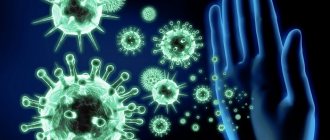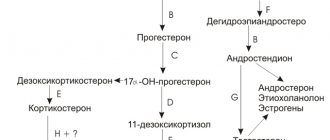Cortisone
The incidence and severity of side effects depend on the duration of use, the size of the dose used and the ability to comply with the circadian rhythm of the prescription.
From the endocrine system
: decreased glucose tolerance, “steroid” diabetes mellitus or manifestation of latent diabetes mellitus, suppression of adrenal function, Itsenko-Cushing syndrome (moon-shaped face, pituitary-type obesity, hirsutism, increased blood pressure, dysmenorrhea, amenorrhea, myasthenia gravis, stretch marks), delayed puberty development in children.
From the digestive system
: nausea, vomiting, pancreatitis, “steroid” gastric and duodenal ulcers, erosive esophagitis, bleeding and perforation of the gastrointestinal tract, increased or decreased appetite, flatulence, hiccups. In rare cases, increased activity of liver transaminases and alkaline phosphatase.
From the cardiovascular system
: arrhythmias, bradycardia (up to cardiac arrest); development (in predisposed patients) or increased severity of heart failure, ECG changes characteristic of hypokalemia, increased blood pressure, hypercoagulation, thrombosis. In patients with acute and subacute myocardial infarction, the necrosis focus spreads, the formation of scar tissue slows down, which can lead to rupture of the heart muscle.
From the nervous system
: delirium, disorientation, euphoria, hallucinations, manic-depressive psychosis, depression, paranoia, increased intracranial pressure, nervousness or anxiety, insomnia, dizziness, vertigo, pseudotumor of the cerebellum, headache, convulsions.
From the senses
: posterior subcapsular cataract, increased intraocular pressure with possible damage to the optic nerve, a tendency to develop secondary bacterial, fungal or viral eye infections, trophic changes in the cornea, exophthalmos.
Metabolism
: increased excretion of calcium ions, hypocalcemia, increased body weight, negative nitrogen balance (increased protein breakdown), increased sweating. Caused by mineralocorticoid activity: fluid and sodium ion retention (peripheral edema), hypernatremia, hypokalemic syndrome (hypokalemia, arrhythmia, myalgia or muscle spasm, unusual weakness and fatigue.
From the musculoskeletal system
: slower growth and ossification processes in children (premature closure of epiphyseal growth zones), osteoporosis (very rarely - pathological bone fractures, aseptic necrosis of the head of the humerus and femur), rupture of muscle tendons, “steroid” myopathy, decreased muscle mass (atrophy).
From the skin and mucous membranes
: delayed wound healing, petechiae, ecchymosis, skin thinning, hyper- or hypopigmentation, “steroid” acne, stretch marks, tendency to develop pyoderma and candidiasis.
Allergic reactions
: generalized (skin rash, itching, anaphylactic shock), local allergic reactions.
Others
: development or exacerbation of infections (the appearance of this side effect is facilitated by jointly used immunosuppressants and vaccination), leukocyturia, withdrawal syndrome.
Cortisone tablets 25 mg 80 pcs.
From the endocrine system: decreased glucose tolerance, “steroid” diabetes mellitus or manifestation of latent diabetes mellitus, suppression of adrenal function, Itsenko-Cushing syndrome (moon-shaped face, pituitary-type obesity, hirsutism, increased blood pressure, dysmenorrhea, amenorrhea, myasthenia, striae ), delayed sexual development in children. From the digestive system: nausea, vomiting, pancreatitis, “steroid” gastric and duodenal ulcers, erosive esophagitis, bleeding and perforation of the gastrointestinal tract, increased or decreased appetite, flatulence, hiccups. In rare cases, increased activity of liver transaminases and alkaline phosphatase. From the cardiovascular system: arrhythmias, bradycardia (up to cardiac arrest); development (in predisposed patients) or increased severity of heart failure, ECG changes characteristic of hypokalemia, increased blood pressure, hypercoagulation, thrombosis. In patients with acute and subacute myocardial infarction, the necrosis focus spreads, the formation of scar tissue slows down, which can lead to rupture of the heart muscle. From the nervous system: delirium, disorientation, euphoria, hallucinations, manic-depressive psychosis, depression, paranoia, increased intracranial pressure, nervousness or anxiety, insomnia, dizziness, vertigo, pseudotumor of the cerebellum, headache, convulsions. From the senses: posterior subcapsular cataract, increased intraocular pressure with possible damage to the optic nerve, a tendency to develop secondary bacterial, fungal or viral eye infections, trophic changes in the cornea, exophthalmos. From the metabolic side: increased excretion of calcium ions, hypocalcemia, increased body weight, negative nitrogen balance (increased protein breakdown), increased sweating. Caused by mineralocorticoid activity: fluid and sodium ion retention (peripheral edema), hypernatremia, hypokalemic syndrome (hypokalemia, arrhythmia, myalgia or muscle spasm, unusual weakness and fatigue). From the musculoskeletal system: slowing of growth and ossification processes in children (premature closure of the epiphyseal growth zones), osteoporosis (very rarely - pathological bone fractures, aseptic necrosis of the head of the humerus and femur), rupture of muscle tendons, “steroid” myopathy, decreased muscle mass (atrophy). From the skin and mucous membranes: delayed wound healing, petechiae, ecchymoses, thinning of the skin, hyper- or hypopigmentation, “steroid” acne, stretch marks, a tendency to develop pyoderma and candidiasis. Allergic reactions: generalized (skin rash, itching, anaphylactic shock), local allergic reactions. Other: development or exacerbation of infections (the appearance of this side effect is facilitated by jointly used immunosuppressants and vaccination), leukocyturia, withdrawal syndrome.
Cortisone acetate
Cortisone is a synthetic glucocorticosteroid drug. It has anti-inflammatory, antiallergic and immunosuppressive effects, increases the sensitivity of beta-adrenergic receptors to endogenous catecholamines.
Interacts with specific cytoplasmic receptors (receptors for glucocorticosteroids (GCS) are found in all tissues, especially in the liver) to form a complex that induces the formation of proteins (including enzymes that regulate vital processes in cells).
Protein metabolism: reduces the amount of globulins in plasma, increases albumin synthesis in the liver and kidneys (with an increase in the albumin/globulin ratio), reduces synthesis and increases protein catabolism in muscle tissue.
Lipid metabolism: increases the synthesis of higher fatty acids and triglycerides, redistributes fat (fat accumulation occurs mainly in the shoulder girdle, face, abdomen), leads to the development of hypercholesterolemia.
Carbohydrate metabolism: increases the absorption of carbohydrates from the gastrointestinal tract; increases the activity of glucose-6-phosphatase (increasing the flow of glucose from the liver into the blood); increases the activity of phosphoenolpyruvate carboxylase and the synthesis of aminotransferases (activation of gluconeogenesis); promotes the development of hyperglycemia.
Water-electrolyte metabolism: retains Na+ and water in the body, stimulates the excretion of K+ (mineralocorticoid activity), reduces the absorption of Ca2+ from the gastrointestinal tract, causes “leaching” of calcium from the bones and increases its renal excretion, reduces bone mineralization.
The anti-inflammatory effect is associated with inhibition of the release of inflammatory mediators by eosinophils and mast cells; inducing the formation of lipocortins and reducing the number of mast cells that produce hyaluronic acid; with a decrease in capillary permeability; stabilization of cell membranes (especially lysosomal) and organelle membranes. Acts on all stages of the inflammatory process: inhibits the synthesis of prostaglandins (Pg) at the level of arachidonic acid (lipo-cortin inhibits phospholipase A2, suppresses the liberation of arachidonic acid and inhibits the biosynthesis of endoperoxides, leukotrienes, which contribute to inflammation, allergies, etc.), the synthesis of “pro-inflammatory cytokines” ”(interleukin 1, tumor necrosis factor alpha, etc.); increases the resistance of the cell membrane to the action of various damaging factors. The immunosuppressive effect is caused by the involution of lymphoid tissue, inhibition of the proliferation of lymphocytes (especially T-lymphocytes), suppression of the migration of B-cells and the interaction of T- and B-lymphocytes, inhibition of the release of cytokines (interleukin-1, 2; interferon gamma) from lymphocytes and macrophages and decreased antibody formation.
The antiallergic effect develops as a result of a decrease in the synthesis and secretion of allergy mediators, inhibition of the release of histamine and other biologically active substances from sensitized mast cells and basophils, a decrease in the number of circulating basophils, suppression of the development of lymphoid and connective tissue, a decrease in the number of T- and B-lymphocytes , mast cells, reducing the sensitivity of effector cells to allergy mediators, suppressing antibody formation, changing the body’s immune response. In obstructive diseases of the respiratory tract, the effect is due mainly to inhibition of inflammatory processes, prevention or reduction of the severity of swelling of the mucous membranes, reduction of eosinophilic infiltration of the submucosal layer of the bronchial epithelium and deposition of circulating immune complexes in the bronchial mucosa, as well as inhibition of erosion and desquamation of the mucosa. Increases the sensitivity of beta-adrenergic receptors of small and medium-sized bronchi to endogenous catecholamines and exogenous sympathomimetics, reduces the viscosity of mucus by reducing its production.
Suppresses the synthesis and secretion of ACTH and, secondarily, the synthesis of endogenous corticosteroids. Inhibits connective tissue reactions during the inflammatory process and reduces the possibility of scar tissue formation. The drug is almost completely absorbed from the gastrointestinal tract. Its maximum concentration in the blood is reached after 1-2 hours, the effect of the drug lasts for 6-8 hours.
Free cortisol and cortisone (HPLC/MS)
Urine cortisol test
- a screening test used in the diagnosis of Cushing's syndrome.
List of tests included in the study:
- free cortisol;
- free cortisone;
- cortisol/cortisone.
Cortisol
is a steroid hormone produced in the adrenal cortex and is involved in the hormonal regulation of body functions in stressful situations. Its release by the adrenal glands is controlled through a classic negative feedback loop involving corticotropin-releasing factor from the hypothalamus and adrenocorticotropic hormone (ACTH) from the pituitary gland.
Functions of cortisol:
- participates in the development of adaptive reactions to stress, including physical stress;
- regulates blood pressure;
- affects the metabolism of carbohydrates and lipids;
- participates in the regulation of sodium and potassium;
- stimulates protein biosynthesis in the liver.
An increase in cortisol levels is observed in Cushing's disease and syndrome and is accompanied by the development of obesity with the formation of red-violet stretch marks on the skin, arterial hypertension, impaired glucose tolerance, and menstrual irregularities.
Cushing's disease is the most common cause of cortisol hyperproduction, associated with hypersecretion of ACTH by pituitary microadenoma. Itsenko-Cushing's disease is characterized by increased production of cortisol and loss of the normal daily rhythm of its secretion (normally, cortisol secretion decreases in the evening). An increase in cortisol can be detected with hypothyroidism, uncompensated diabetes mellitus, stress, pain, and fevers. A decrease in cortisol concentration is detected in primary adrenal insufficiency, Addison's disease, and pituitary pathology.
Determination of 24-hour urine cortisol is the most sensitive and specific test for initial screening of Cushing's syndrome, allowing it to be differentiated from simple obesity. The diurnal variations in cortisol secretion characteristic of blood cortisol levels are not evident when urine is collected over a 24-hour period. Excretion of free cortisol is less than 1% of the volume of its daily secretion by the adrenal glands, but quite adequately reflects the latter.
If elevated cortisol levels are detected, functional causes of hypercortisolism should be excluded. Assessments related to the circadian biological rhythm of cortisol are not informative in people who work night shifts and/or frequently cross time zones.
The level of free cortisol in the urine closely corresponds to the content of free (not bound to carrier proteins) cortisol in the serum and is the most reliable and valuable indicator of the rate of secretion of this hormone. Since it is cortisol that is determined, and not its metabolites, daily fluctuations in the excretion of cortisol metabolites do not affect the results of the analysis. Urinary free cortisol levels are elevated in approximately 95% of patients with Cushing's syndrome. If >250 mcg of cortisol is excreted per day, the diagnosis of this syndrome is beyond doubt.
Indications:
- Diagnosis of Cushing's syndrome.
Preparation
In the morning, empty your bladder (this portion of urine is poured into the toilet). Record the time of urination, for example: “8:00”. Over the next 24 hours, collect all excreted urine in a dry, clean container with a capacity of 2–3 liters.
After urine collection is completed, the contents of the container must be accurately measured. The container must indicate the daily volume of urine (diuresis) in milliliters. For example: “Diuresis: 1250 ml.”
Be sure to mix the urine thoroughly and immediately pour 50–60 ml into a sterile container with a lid. There is no need to bring all the urine collected during the day.
During the entire collection period and until shipment, the biomaterial should be stored in a refrigerator at 2–8°C. The material must be delivered to the medical office on the day the collection ends.
If possible, you should stop taking medications 3 days before. The day before collecting urine, you should not eat foods that can color it (for example, beets, carrots, etc.). You should also avoid drinking alcohol and eating spicy foods.
Interpretation of results
Units: nmol/day.
Increasing values:
- Cushing's syndrome;
- late stages of pregnancy;
- stress;
- ACTH-secreting tumors;
- pseudo-Cushing's syndrome.


